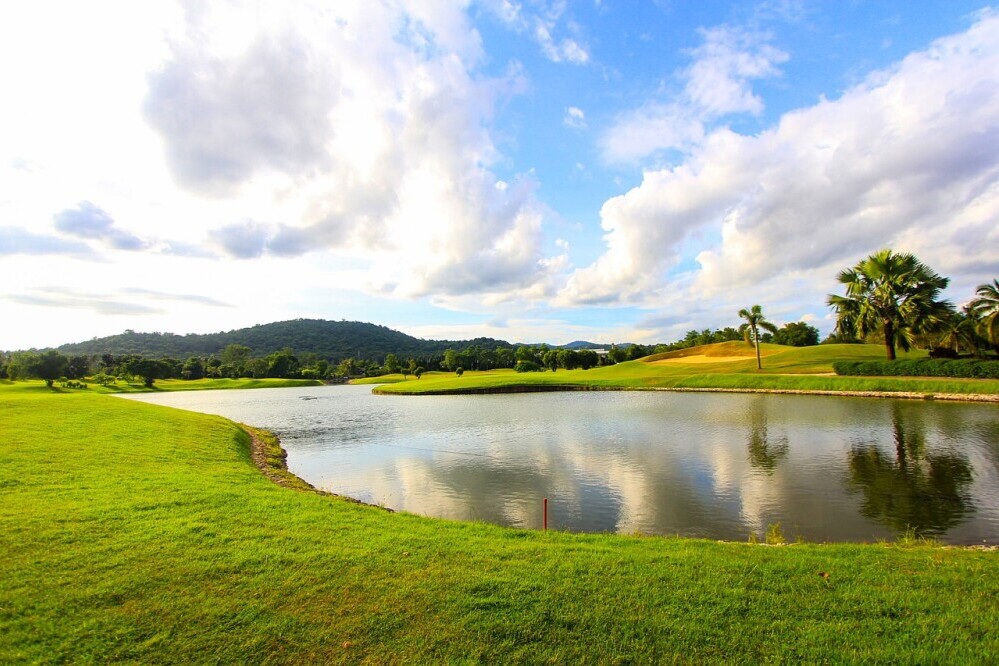Navigating Water-Heavy Courses With Smart Shot Selection


Fore! Quick note: a few links here are affiliate links. If you snag gear through them, I earn a small commission — no extra strokes added to your game.
Water-heavy courses present a unique set of challenges that many golfers find both thrilling and intimidating. These courses often feature numerous lakes, ponds, and streams that can quickly turn a promising round into a struggle to stay dry. Thankfully the golf viking has you covered with the best tips to help you survive the course without needing your waders.
Understanding how these water hazards shape the course layout and influence strategy is key to managing them effectively. Pay attention to where the water features are on each hole you play, because you’ll need to strategize how to avoid them and keep your ball dry.
One of the main issues with water hazards is their ability to completely disrupt play. Even a slight miscalculation or mishit can lead to penalties that might hurt your overall score. Hit the ball in the water once, and it’s already adding extra strokes to your hole. Hit it in the water multiple times and you might think about throwing your clubs into the water.
The pressure of needing to avoid these hazards can also play on a golfer’s mind, sometimes leading to hurried or cautious shots that lack conviction. The best way to avoid them is to make the smartest play to keep your ball away from the water altogether.
Strategic thinking becomes essential when navigating courses with significant water features. It’s not just about avoiding the water, but also understanding the best angles and approaches to take advantage of the course layout.
This involves assessing each hole individually, factoring in where water comes into play, and planning your shots to mitigate risks while still aiming for an optimal path to the hole. There may be times when the best option is to hit around the water in order to keep yourself from going swimming.
By embracing a tactical approach and respecting the challenges these water hazards introduce, you can transform a daunting round into an opportunity for strategic mastery. It may not be as intense as shooting the ball over the pond, but it may just save your scorecard.
This mental framework is not only beneficial for dealing with water-heavy courses, but it also enhances overall decision-making skills in golf. So how do water features affect your round while out on the course?
Want to dial in your precision when water is in play? Our guide to the most accurate golf putters will help you avoid costly mistakes around the green.

Understanding Water Hazards and Their Impact
Golfers often encounter various types of water hazards, each presenting its own unique set of obstacles. From sprawling lakes to narrow streams winding through the course, these water elements are strategically placed to challenge and test a player’s precision and skill.
Knowing the specific characteristics of these hazards can help in crafting a game plan that keeps them from ruining your score. For example, if you are near a shallow creek you can trust that you’ll be able to clear it without any problems.
But if you’re hitting towards a large pond that’s just at the edge of your maximum distance, you might consider hitting it shorter or around rather than risk ending up in the water.
The impact of water hazards extends beyond the physical boundary it creates on the course. At their core, these features are designed to impose penalties and challenge decision-making skills. It’s all part of the beautiful strategy of golf, and ultimately it’s up to you to decide how you want to utilize it.
A ball that lands in the water forces the player to take a drop and incur a one-stroke penalty, which can quickly add up and make it difficult to recover, regardless of your skill level. So if playing on a course with lots of water features, the conservative approach may serve you better.
There’s also a psychological aspect to consider when dealing with water on the course. The sight of substantial water bodies can instill doubt and anxiety, even among seasoned golfers, potentially leading to rushed or overly cautious shots. There may be times when you do end up in the pond, but don’t let it affect your overall game to make it worse.
This psychological barrier can be as daunting as the physical hazard itself, affecting confidence and shot execution. But you can’t let the course scare you into not playing with confidence.
Effectively tackling water hazards requires not only tactical shot planning but also a strong mental game. Understanding how to calmly approach and manage the mental stress associated with these obstacles is crucial.
By focusing on routines that enhance concentration and lessen anxiety, golfers can gain control over their game and approach each water-dense hole with confidence. So how can we avoid these hazards and keep our ball nice and dry?
Sometimes a well-controlled fade or draw can help you steer clear of hazards—learn the techniques for fades and draws in golf to gain confidence near water.

Smart Strategies to Avoid Water Hazards
When it comes to navigating a course with plenty of water hazards, having a solid strategy is key. Carefully mapping out the course before play can offer valuable insights into the specific challenges it presents. Know what you’re getting into before you even take your first shot.
Identifying potential trouble spots on each hole allows you to plan the best routes and avoid unpleasant surprises. If there is a massive pond that runs along one side of the fairway, maybe play along the other side even if it’s not as close to the green. But knowing where the water features are and hitting away from them can help.
One effective approach is using visual markers or landmarks on the course that can guide your play. By focusing on these markers instead of the water itself, you’re less likely to let anxiety influence your shots. Aim for spots that give you best shot at staying on land.
It’s all about shifting focus to the safe zones and setting realistic targets that you’re comfortable hitting. This might include hitting your ball shorter on some holes, but this will prove to serve you better than getting extra strokes from hitting your ball into the water.
Enhancements in your pre-shot routine can also play a crucial role in staying dry. This might involve adjusting your stance, taking practice swings to find the right tempo, and visualizing the shot’s trajectory. Get a few practice swings in so you get a feel for it.
These small changes can boost confidence and improve shot consistency, which are both important when trying to avoid water hazards. Besides staying consistently on land isn’t so bad, right?
Remember that playing it safe doesn’t mean being overly conservative. Instead, it’s about assessing your strengths and using them effectively to navigate challenging stretches. Ultimately it may save you in the end.
By avoiding unnecessary risks and sticking to a game plan that suits your playing style, you can significantly reduce the chances of water impacting your score. It’s all about the appropriate shot selection at the appropriate times.
When a long carry over water feels risky, use these strategies for managing risk vs reward on long approach shots.

Empowering Smart Shot Selection
When playing a course full of water hazards, making smart shot selections is crucial. The temptation to rely on power over precision can be a tough habit to break, but focusing on accuracy can yield better results and add stability to your game.
Start by evaluating each shot with a clear understanding of where the water comes into play. Instead of going for glory, think about where you want your ball to land, taking into account run-off areas that can prevent wet mishaps.
This approach means choosing the right trajectory and club strength to keep the ball clear of danger. If you need to get a shorter club so that you don’t end up in the drink, that’s fine. Adjust your club to get your ball to the safest spot, not just the furthest.
Prioritize analyzing the best lines for play by studying each hole’s layout. Identifying optimal angles can help you safely navigate the hole, even if it means sacrificing a bit of distance for a better position. Knowing the best lines to get you to the green safely will help you stay out of trouble .
This method of playing smart gives you more control over where the ball goes and less chance of it ending up in the drink. You don’t need to try to go for distance every time. The shot that keeps you away from hazards is usually the best shot.
Balancing risk and reward is key. Sometimes laying up short of the water and setting yourself up for a better next shot is smarter than attempting a high-risk play that could land you in trouble. Knowing when to pull back and play it safe is just as crucial as knowing when to be aggressive.
Ultimately, approaching each shot with clarity and a strategic mindset minimizes errors and builds confidence. As you refine these techniques, you’ll find that your adaptability and foresight improve, making even the most water-laden courses feel like just another enjoyable round to conquer.
Course features can amplify difficulty—see our tips on how to adjust your strategy for mountainous courses to prepare for uneven lies and tricky visuals.

Choosing the Right Clubs for Water-Heavy Challenges
Selecting the right clubs plays a vital role in avoiding water hazards. Often, it’s not about how far you can hit, but about hitting the right distance to steer clear of trouble. Understanding your club distances and their performance under different conditions can make all the difference.
Consider wind conditions and how they affect ball flight, especially near water. Using clubs that provide more loft can help the ball land softly, minimizing the chances of it rolling into water hazards. This might mean opting for a pitching wedge instead of a 9-iron or using a hybrid for more control over longer distances.
Adaptive play means being flexible with your club choices based on the course layout each day. Conditions on the course can change rapidly, and the ability to adjust your club selection to account for these changes ensures higher accuracy and confidence. Don’t be stubborn using the same club for everything. Adjust your clubs to maximize your chances for success.
Practicing with a variety of clubs during rounds can help you feel more prepared to tackle any scenario, including those daunting water-crossing shots. Knowing you have the right club matched with the right shot can ease the stress that often accompanies water-heavy courses.
Fine-tuning your club selection not only enhances performance but also builds a level of comfort in your game. When you’re confident in your club choices, it translates to better play and fewer penalties, even on the most challenging water-filled courses. I’ll see you out on the golf course, staying ever dry.


